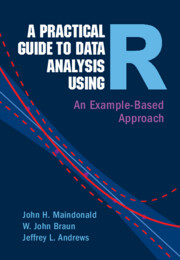Book contents
- Frontmatter
- Dedication
- Contents
- Figures
- Preface
- 1 Learning from Data, and Tools for the Task
- 2 Generalizing from Models
- 3 Multiple Linear Regression
- 4 Exploiting the Linear Model Framework
- 5 Generalized Linear Models, and Survival Analysis
- 6 Time Series Models
- 7 Multilevel Models, and Repeated Measures
- 8 Tree-Based Classification and Regression
- 9 Multivariate Data Exploration and Discrimination
- Appendix A The R System: a Brief Overview
- References
- References to R Packages
- Index of R Functions
- Index of Terms
5 - Generalized Linear Models, and Survival Analysis
Published online by Cambridge University Press: 11 May 2024
- Frontmatter
- Dedication
- Contents
- Figures
- Preface
- 1 Learning from Data, and Tools for the Task
- 2 Generalizing from Models
- 3 Multiple Linear Regression
- 4 Exploiting the Linear Model Framework
- 5 Generalized Linear Models, and Survival Analysis
- 6 Time Series Models
- 7 Multilevel Models, and Repeated Measures
- 8 Tree-Based Classification and Regression
- 9 Multivariate Data Exploration and Discrimination
- Appendix A The R System: a Brief Overview
- References
- References to R Packages
- Index of R Functions
- Index of Terms
Summary
Generalized linear models extend classical linear models in two ways. They allow the fitting of a linear model to a dependent variable whose expected values have been transformed using a "link" function. They allow for a range of error families other than the normal. They are widely used to fit models to count data and to binomial-type data, including models with errors that may exhibit extra-binomial or extra-Poisson variation. The discussion extends to models in the generalized additive model framework, and to ordinal regression models. Survival analysis, also referred to as time-to-event analysis, is principally concerned with the time duration of a given condition, often but not necessarily sickness or death. In nonmedical contexts, it may be referred to as failure time or reliability analysis. Applications include the failure times of industrial machine components, electronic equipment, kitchen toasters, light bulbs, businesses, loan defaults, and more. There is an elegant methodology for dealing with "censoring" – where all that can be said is that the event of interest occured before or after a certain time, or in a specified interval.
Keywords
- Type
- Chapter
- Information
- A Practical Guide to Data Analysis Using RAn Example-Based Approach, pp. 245 - 291Publisher: Cambridge University PressPrint publication year: 2024



